Installation at Art Galerie
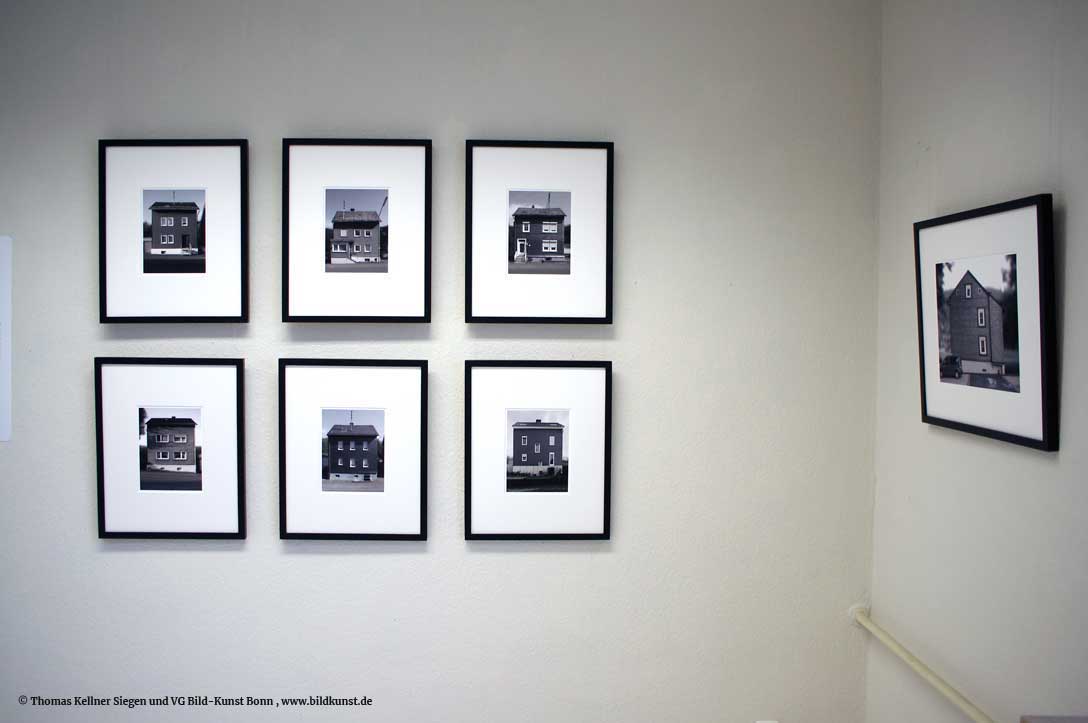
Half-timbered buildings of the Siegen industrial area today
Documentary fine art photography, half-timbered buildings from the region around Siegen, timeless images of culture and society in the Siegerland. This list seems to allude inevitably to the well-known works of Bernd and Hilla Becher, their photographs of half-timbered houses, industrial architecture and the typology. Since 2021, however, the statements also fits the Siegerland artist, who follows in the footsteps of the Bechers in staging half-timbered buildings. In a series of 19 architectural photographs, the artist shows selected Eiserfeld half-timbered architectures in their present state, which belong to the typology. As a historical comparison, he contrasts Bernd and Hilla Becher's black-and-white photographs of the 1960s with his own images.
Half-timbered architectures typology in comparison with Bernd and Hilla Becher
Without limiting the recognizable connection between the two works, Kellner gives the photographs his own signature and plays "with the transformation into black and white, the shadowing, the focus on details that remain in color, the dreamy blur in the background." (Dr. Andrea Gnam) In this way, his photographs act as independent artworks of the Siegerland's way of life and in parallel fulfill a comparative function. By revealing motivic and methodological differences to the Bechers in direct comparison, similar to a search picture, his typology of works is not only a mirror of a changing residential culture and part of social and residential history, but also testimony to an evolving, artistic photography. The photographs open up a view of the polarity of a building that has been altered by visual modernization measures over time and resembles the original building only in form. The appraisal and condemnation of the emerging changes in the subject is as dualistic as the architectural structure itself. However, there is no mistaking that the half-timbered houses of 2021 lost their identity and were to some extent "deprived of their expression," (Dr. Andrea Gnam) but in the work of the fine-art photographer they return to a magical realism.
"The photographer has 'played' with us in this model world - understood in the aesthetic sense - in a well-considered way” Dr. Andrea Gnam in Thomas Kellner – Fachwerkhäuser Des Siegener Industriegebietes Heute, edited by Oliver Seltmann. 500th ed., 8–11. Berlin: Seltmann Publishers, page 11.
Photographs
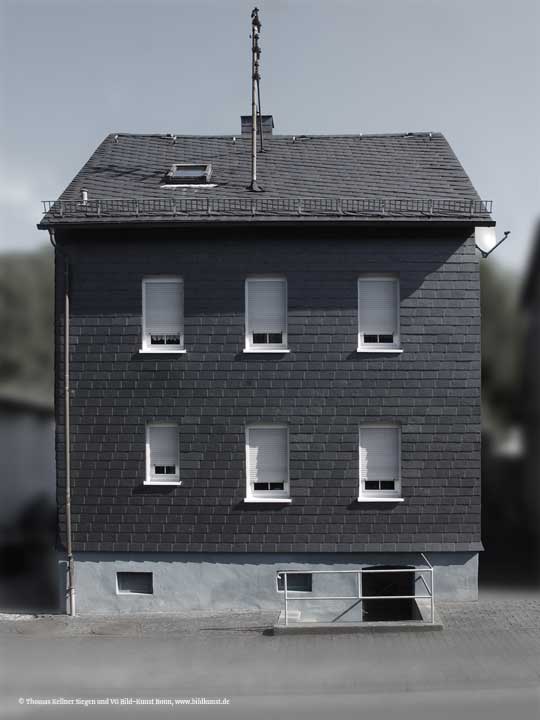
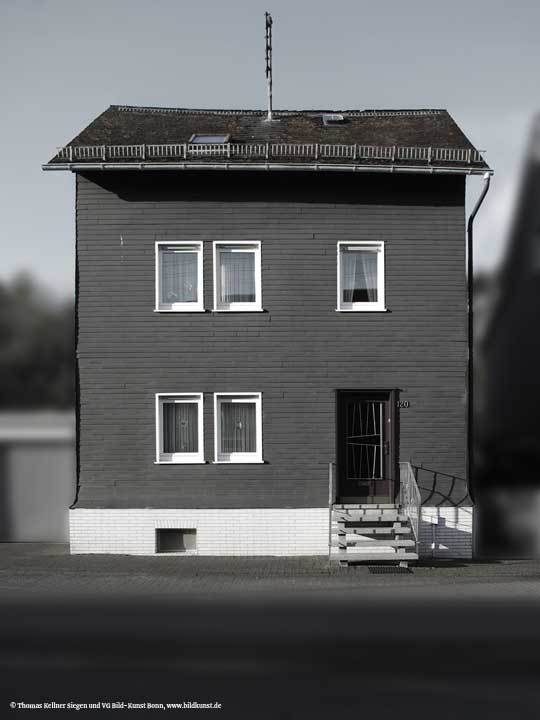
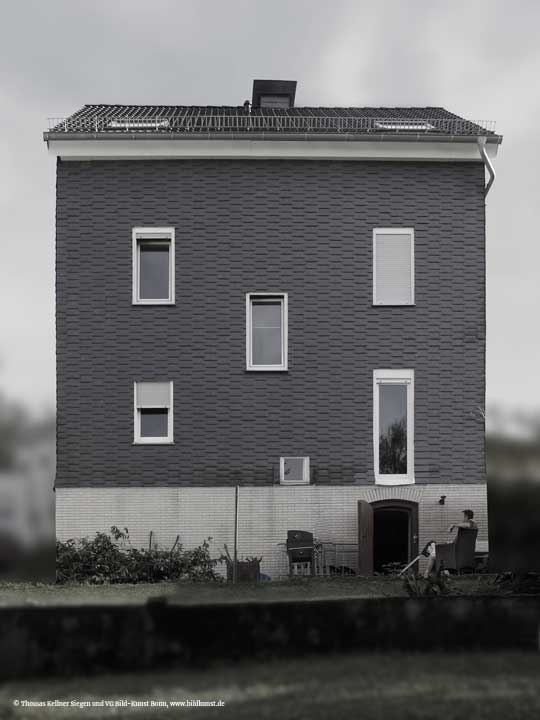
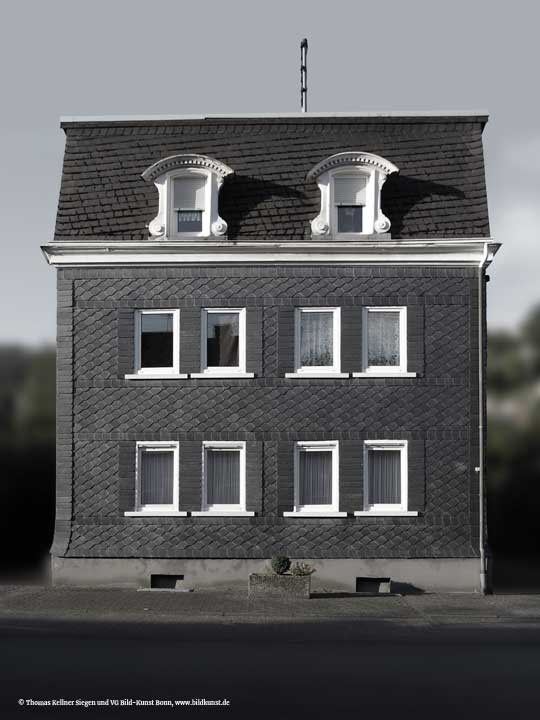
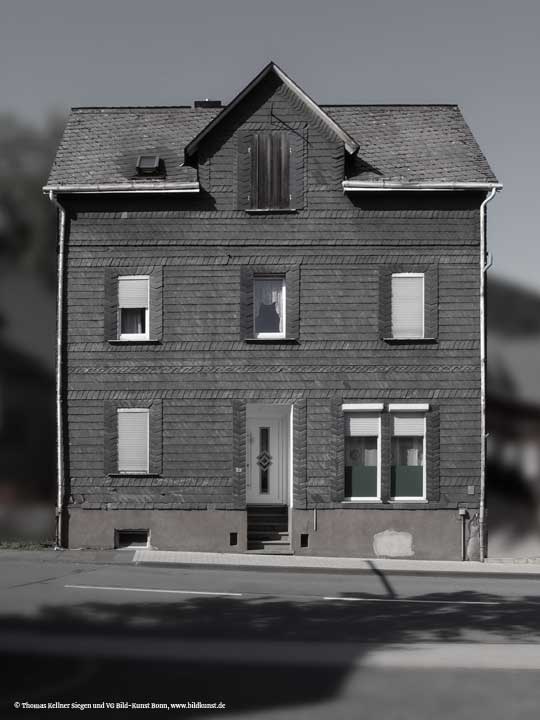
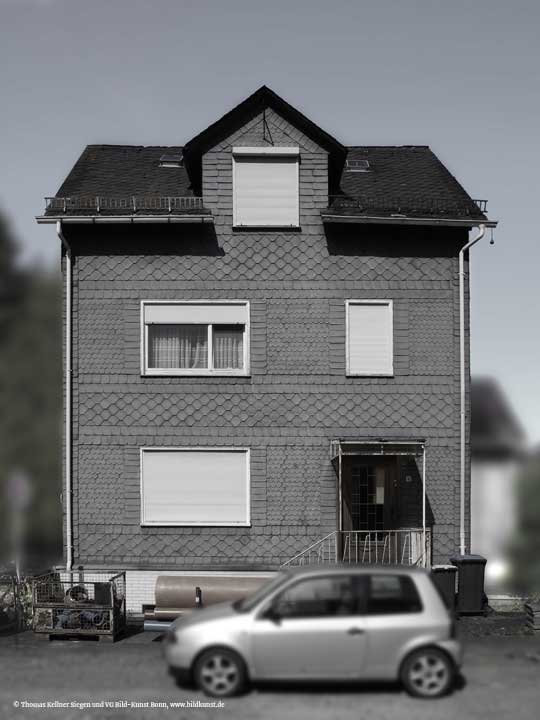
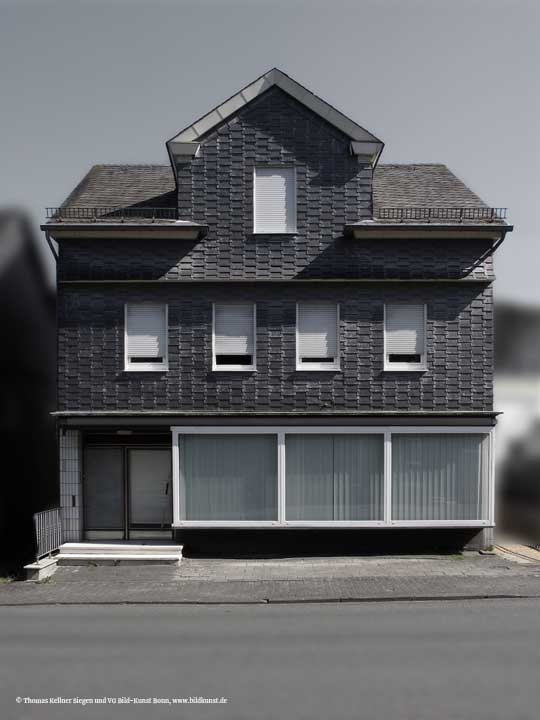
All images, all prices here Interested? Contact me!
Bernd and Hilla Becher: Half-timbered houses of the Siegen industrial area
For organisational and economic reasons, the Bernd and Hilla Becher focused on photographing regional industrial history at the beginning of their fine art photographic career. This included the views of halftimbered houses in the Siegerland region taken from the late 1950s to the early 1970s. The connection between these halftimbered buildings and the industrially oriented documentation in the oeuvre of Bernd and Hilla Becher has its origins in the economic orientation of the Siegerland. This region was primarily characterised by mining and devoted to the extraction of iron. The improvements in mining and metallurgy with the switch from charcoal to coke smelting in the mid-19th century led to a veritable boom in the Siegerland in 1864. The increase in the labour force led to an increase in the demand for housing and, in combination with a prescribed low-wood construction method, resulted in an increase in the number of houses built in halftimbered construction.
A historical typology of Bernd and Hilla Becher
With their series of half-timbered houses in the Siegerland, Bernd and Hilla Becher documented not only economic and historical developments but also the effects on the history of building and settlement in the industrial area, from which they subsequently developed their typology. The views of individual halftimbered architectures and village views make it clear that the economic structure, materials and raw materials as well as working conditions of an area have an impact on its appearance. The series of half-timbered houses unites buildings which, according to their function, are living spaces and thus at the same time illustrate an individual image of their builders and inhabitants as well as the Siegerland regional (building) culture. The half-timbered houses built by miners, smelters and craftsmen become a mirror of a living situation and way of life that blurs between everyday use and a need for representation.
New perspectives through fine art photography
The fine art photographer couple staged the buildings according to their standardized principle and usually produced one or two frontal views per half-timbered house. The panoramic views, consisting of four different perspectives, show both glazed and ornamental street views and the raw half-timbered walls on the gable or rear side. These different designs on one and the same house point to the individual character of the half-timbered houses depending on the self-representation intentions and financial means of the builders. By bringing the half-timbered houses, the associated self-image and the cultural background into designed form, Bernd and Hilla Becher visualized parts of the social and economic history in the context of heavy industry.
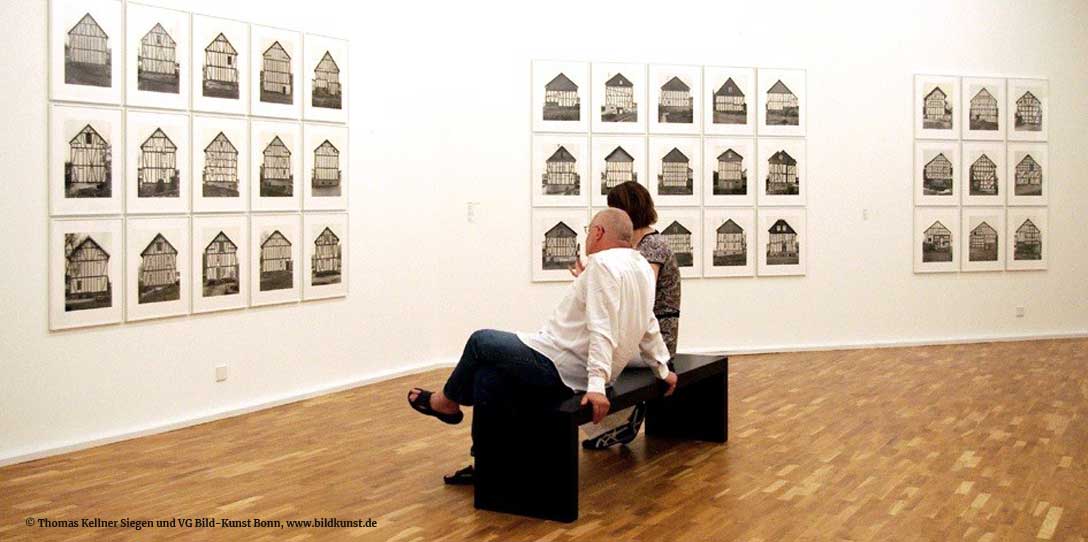
Half-timbered houses in Siegerland:A new typology
Since 2021 Thomas Kellner opposes Bernd and Hilla Becher's typologyof the halftimbered houses in the Siegerland region to his own fine art photographs. On the trail of Bernd and Hilla's typology, he photographed the halftimbered houses in their present condition in the city district of Eiserfeld. Elements of documentary photography combine with artistic approaches and conceptions in a series of 19 architectural photographs to a typology of their own. In his fine art photography, the artist works with shadows as well as a background remaining in blur and transforms the color scheme in a black and white image with colored details. In this manner, the photographer presents a monochrome half-timbered house with situational remnants of everyday life that are compositionally emphasized.
The changing world
His fine art photography creates a contrast within the Becher’s black and white ptypology of the 1960’s. In this way, the artist documents the optical modernization measures which have little to do with the original condition of the halftimbered houses. The fine art photograher's typology assumes a comparative function, invites to the analysis of architecture and is considered as independent artwork of a regional way of life in Siegerland, without restricting the connection to Bernd and Hilla Becher’s typology. The fine art photography illustrates a man-made change, a transformed zeitgeist and opens the view to the polarity of a building. Besides the artist's use of a digital reflex camera, also the subsequent processing of the photographs refers to the 21st century in terms of photographic technology. Similar to a search picture, motivational and methodological differences to the half-timbered houses of the Becher’s typology get evident in the direct comparison. In that way, Thomas' typolgy is not only a mirror for a changing home culture and part of the social and hosing history in the Siegerland region, but also testimony of a progressive fine art photography.
The typology of the fine art photographers Becher
Bernhard and Hilla Becher devoted their entire lives to black-and-white fine art photography. In doing so, they subjected the photographs, which were grouped together in tableaux, to a systematic design principle that, although mainly documentary in nature, is nevertheless more than a mere reproduction of what is there. Through a conscious realisation based on a structured method, the artist couple developed a fine art form of photography that visually fixed industrial cultural and contemporary history. From the 1960s onwards, they photographed ideal-typical forms of heavy industry, starting with the industrial area of the Siegerland and Ruhr regions and extending to European and North American prototypes of the industrial landscape. The image of blast furnaces, winding towers and water towers as well as dwellings and houses became a manifestation of economic and social-historical phenomena of the industrial age. The Bechers sorted their photographs according to different types of buildings. These typologically divided groups of works are comparative series and reveal an overarching pattern within a grouping. The half-timbered houses formed thus a group. The Bechers' tableaus therefore illustrate analogies and differences between architectural buildings of the same function and made of the same building material. The organising principle pursued by Bernd and Hilla Becher was thus a design and visual Typology according to construction and function correspondences.
Fine art photography as documention
Their fine art photographic documentation was realised with a 13 x 18 cm plate camera. This enabled the fine art photographs to achieve distortion-free reproduction and uniform depth of field. In addition to the choice of camera, the time and point of view were important. They achieved a comparable image of buildings through consistent lighting conditions and weather conditions, which were useful to them when taking photographs in late autumn and spring. The active process of image creation was always carried out from an elevated shooting position, although its implementation could vary depending on the location. The Bechers' fine art is therefore a documentation dependent on external factors, which becomes fine art photography through an ideal-typical execution of the shooting process, a structured grouping of images into a series and an enlightening claim.
Bernd and Hilla Becher
The photographer Bernd Becher, who came from the Siegerland region, and his wife Hilla Becher gained international renown as photographers with their black-and-white photographs of industrial buildings and half-timbered houses, thanks to their distinctive style of fine art photography. The Dusseldorf Photo School was founded by them at the Academy of Arts in Dusseldorf. Bernd Becher studied from 1953 to 1956 painting at the State Academy of Fine Arts in Stuttgart and typography at the Dusseldorf Art Academy from 1959 to 1961. Starting in 1957, he made photographs that served as documentation and as models for drawings and paintings, and he also collected contact prints of industrial buildings. Together with his wife, he arrived at purely photographic documentation via collages of drawings and photographs, which is how they developed typology. Apart from their documentation of Siegen half-timbered houses, the artist couple always pursued the depiction of industrial production facilities and industrial buildings related to the production of goods. Their images are often unwindings, consequently several photographs showing the same building from different angles. The couple saw themselves as archaeologists of industrial architecture and in this context coined the term "nomadic architecture" for industrial buildings. This term refers to the construction and also the demolition of industrial buildings with a view to capital exploitation and profit-making. Relatively quickly, their photographic work was artistically recognized and appreciated. It is considered a series concept in the sense of New Objectivity and, from the point of view of fine art photography, is assigned to conceptual art. In 1972 Bernd Becher took over a professorship for photography at the Dusseldorf Art Academy and, working closely with Hilla Becher, trained a number of photographic personalities. Bernd Becher died in a Rostock hospital on June 22, 2007. After the death of her husband, Hilla Becher continued the photo-artistic work with new works until she also died on October 10, 2015 .
The Dusseldorf school of photography by Bernd and Hilla Becher
The artistic work of Bernd and Hilla Bercher shapes a whole generation of young fine art photographers far beyond the Siegerland region. The Becher- or Dusseldorf photography school unites photographers whose artistic work began under the teaching of Bernd Becher in the art academy in Dusseldorf. He accompanied from 1976, in constant collaboration with his wife, students of fine art photography for a period of 20 years. The label of Bernd Becher’s class using photography has advantages and disadvantages for the former students. Particularly well-known are Andreas Gursky, Axel Huette, Candida Hoefer, Thomas Struth and Thomas Ruff, who stand, as Becher students, in the succession of Bernd and Hilla Becher, despite their individual art work. The artist couple occupies a special position in art history as representatives of concept photography and the establishment of the medium of photography within the art scene. Accordingly, the reference to the teacher and the pictorial tradition and typology coupled with it is a guarantee for the quality and added value of the fine art photography of a Becher student. As a result of creating artistic freedom in photography, the students developed their own artistic attitudes.
Individual ways
The penchant for the photographic archive and for examining the process of seeing as a process of cognition remains a unifying element between student and mentor. However in terms of photographic art, the students move away from the Becher model and gradually break with the dominance of documentary black-and-white prints, which can also be seen in the series of half-timbered houses in Siegerland. By turning to colour photography, larger print formats or the increasing use of digital technology, subjective influences on fine art photography become visible and their own typologies are developed, which, like Becher's methodology, bring about a change in the classical understanding of photography. The development of Bernd and Hilla Becher into their students who have become artists is part of a continuous art-historical movement that seals the growth of fine art photography in the Bechers' Dusseldorf photography school and carries it on to the Siegerland region.
Thomas Kellner
He was born in Bonn, Germany, in 1966. He studied art, sociology, politics and economics at the University of Siegen in Siegerland. In 1996, he received the Kodak Young Talent Award, which encouraged him to pursue a life as an artist with fine art photography. Since that time, he has lived in Siegen, Germany, as an artist and curator of photographic exhibition projects.
Important Works
His well-known works include the series of pinhole camera photographs Germany - Looking Outside (1996), the series of monuments since 1997, Black & White (1997-2005), Dancing Walls 2003-2006, façades (2004), Brasília - 50 years of a modern utopia (2005-2009), Genius Loci - Two Siegen Citizens in the Czar's Land (2012-2013), Emergency Money for the Greek Culture (2012), My Grandfather was in the SS (2015), Tango Metropolis (2003-2018), If only it were words (2018), Flucticulus (2015-2020), Typology of Siegen's Half-Timbered Houses Today (2021).
Exhibitions and public collection
He has shown his work in solo exhibitions since 1993 in Germany, Australia, England, Russia, China, France, Iceland, Poland, Denmark, Brazil, Syria, Spain, and the United States, and has participated in numerous group exhibitions and publications. His work is included in major private and public collections such as the Art Institute of Chicago, the Museum of Fine Arts in Houston, the Museu de Arte Moderna in Rio de Janeiro, the Baltimore Museum of Art, the Fox Talbot Museum in Lacock Abbey, the George Eastman Museum in Rochester and others. In 2003 he was appointed to the German Society for Photography (DGPh).
Exhibitions
April 14 – May 7, 2023
Kunstverein Ebersberg, Ebersberg, Germany
March 4 – June 2, 2023
in focus Galerie, Cologne, Germany
November 1–30, 2022
Klompching Gallery, 3D-Space, New York, USA
May 31 – September 19, 2022
Architektenkammer Nordrhein-Westfalen, Düsseldorf, Germany
February 14 – May 1, 2021
Art Galerie, Siegen, Germany








